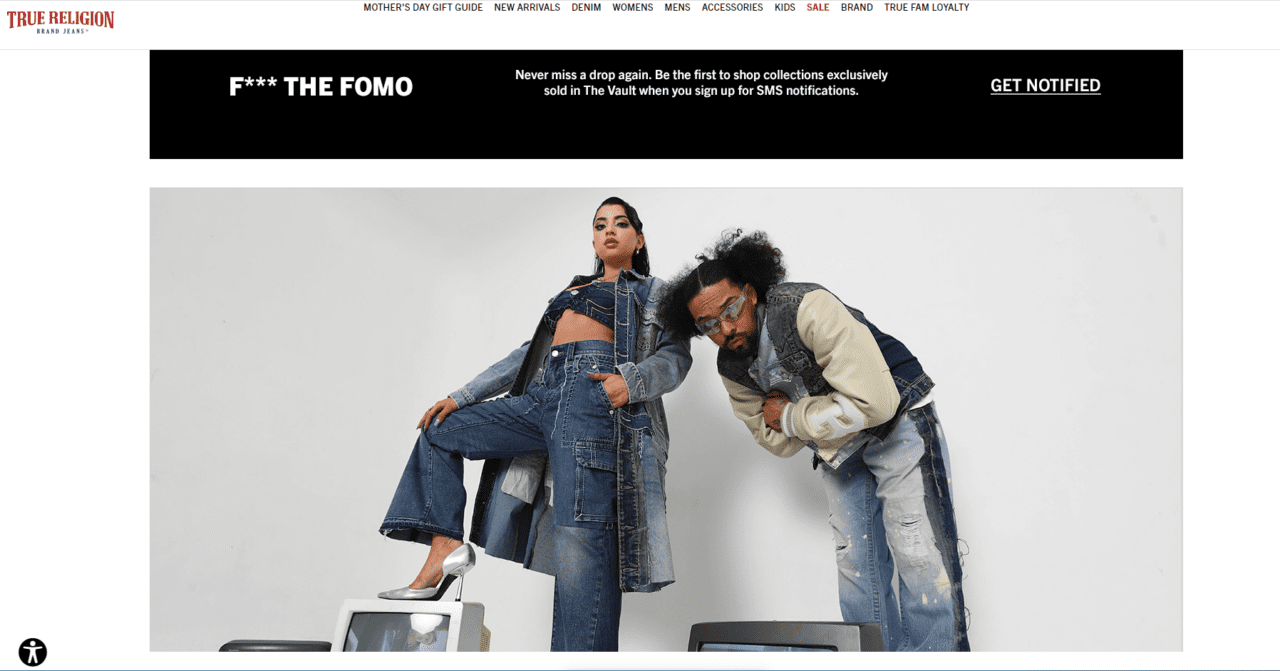How the Y2K Revival is Expanding True Religion’s Shopper Community


True Religion, born in the Y2K era, is benefiting from its current cultural resurgence. Creative Director Zihaad Wells attributes the brand’s heightened relevance among Gen Zers to its strong heritage and distinct design elements: the arch logo, buddha design and, of course, its signature rope stitch.
But Wells knows that to successfully acquire this coveted group of consumers while also retaining its incredibly loyal base of millennial shoppers, the brand can’t simply live in the past. That’s why he and his team are making vigorous efforts to discover some of the fashion industry’s most cutting-edge young designers and artists and to bring them into a growing community of collaborators.
“It’s about being part of a conversation in a really authentic way,” Zihaad said in an interview with Retail TouchPoints. That means fostering a community of brand fans and creators who are passionate about the brand and want to contribute to its already strong legacy.
The True Creators Program is designed to provide several emerging designers with the resources, from manufacturing to materials and marketing support, to craft and launch limited collections for the brand. And because items are crafted using older items from the True Religion archive, True Creators is also a circularity play (another strong selling point for Gen Z).
But the program’s primary goal is to give young creative voices, such as Jaffa Sabba, Blu Boy, Madeline Kraemer, Elijah Popo, Peder Cho and Soldier, a platform to put their own unique spin on the brand — and even monetary support. All design collaborators receive both a design fee and a portion of all sales, adding a stake in the brand to the marketing value that comes with partnering with a household name like True Religion.
Elevating Emerging Artists and Brand Fans
Reflecting on his nearly 15-year tenure with True Religion, Wells noted how much the world of marketing and community-building has changed.
Starting as a Senior Designer in 2006, he worked his way up to VP of Innovation before he left the company in 2017. During this time, as a “lean and mean” team, “We didn’t really have social media, we didn’t do any marketing,” Wells explained. “We could just give products away and people would wear them.”
When he returned to True Religion as creative director in late 2019, social media and the creator economy had reached a critical inflection point. As a result, Wells had to “rethink the way [I] looked at the world and worked with generations.” The True Creators Program allows him to do just that.
“We’ve partnered with these young creatives who use our platform to raise their profile, but in turn, we’re part of a culture and a community that’s doing something different,” Wells said. “They’re already talking about sustainability and circularity in a different way. Necessity is the mother of invention, and you look at all these young creators who are able to create something completely new out of something that exists, and for me, that’s really special.”
True Religion discovers many of its True Creators via Instagram and TikTok, typically favoring people who already have a strong affinity for the brand. Wells noted that many of these creators typically already use True Religion items in their designs, demonstrating their distinct affinity and love for the brand. “That [brand love] was already there, so the question became how do we work with them to bring that love to life?” said Wells. “It’s easy for a brand to take whatever exists in the market and replicate it, but we’re dealing with a world that thrives on authenticity in creative circles. We want to be authentic, and we want to partner with creators to bring it to life, or else people are going to call us out.
While the True Creators Program represents the brand’s biggest investment, True Religion is focused on contributing to the fashion pipeline in other ways. Last year, the brand partnered with the Fashion Scholarship Fund to support a Los Angeles-based student from an underrepresented community pursuing a career in fashion.
Using Mobile as the Community’s ‘Connecting Thread’
As True Religion grows and nurtures its community, digital will obviously be a core component of its strategy. Because the brand is cross-generational, Wells and the True Religion team think strategically about how it engages with newly acquired Gen Z consumers as well as millennials who “grew up” with the brand. Wells knows True Religion needs to be intentional about the channels it uses to connect with consumers.
Social media is a prime channel both for sourcing creator partners and gleaning deeper consumer insights. The brand also frequently incorporates user-generated content from micro- and nano-influencers who are eager to share their love for the brand. But it’s True Religion’s mobile app that aims to bring this love to the next level by offering more exclusive experiences.
Launched in November 2022, the app is still relatively new, but it’s become a key channel for consumers to access exclusive product drops, from original archival pieces to limited-edition collections and refurbished items available via its Vault concept. Consumers also can use the app to access exclusive and interactive content, including interviews with True Religion collaboration partners, user-generated content and styling tips.
“We tend to focus on things that will drive people to the app because we want to give them an exclusive experience on their phones,” Wells explained. More than 80% of the brand’s ecommerce transactions take place via mobile, which makes the app prime real estate for inspiring, and converting, shoppers. By the end of this year, the brand anticipates that the mobile app will account for 10% of total ecommerce sales.
Just this March, True Religion also launched True Fam, a tier-based loyalty program designed to value members’ brand love just as much as the dollars they spend. In fact, the program was co-created and tested with the True Religion community. Featuring three tiers, each is differentiated by spending threshold and rewards. While the lowest level, Opening Act, offers the basic birthday reward and early access to sales, the highest level, Icon, gives the most loyal customers access to exclusive events and members-only sales. “Loyal customers spend 67% more on average than new ones, and the ability to earn rewards influences about two-thirds of consumers’ behavior,” said Scott McCabe, SVP of Digital at True Religion in a statement. “Furthermore, our most valuable customers aren’t just the ones who spend the most money. True Fam allows us to prioritize shoppers who refer True Religion to their friends and family while also tailoring their experiences based on purchase history and tier status.”
As True Religion continues to expand its DTC acquisition and retention strategy across all channels, Wells noted that he and his team will merely build upon what initially inspired the brand’s existence: Unity.
“When I first started at the company [in 2006], I asked [founder Jeffrey Lubell] why the brand was called True Religion. He said that there are many religions in the world, but the one true religion is people and people all wear jeans. For me, that was about unity and ultimately, community. That’s the red thread, the common thread, that holds us all together. If denim is the common thread, we should go outside to the community, beyond the four walls of the brand. That’s through the app and through social media.”











